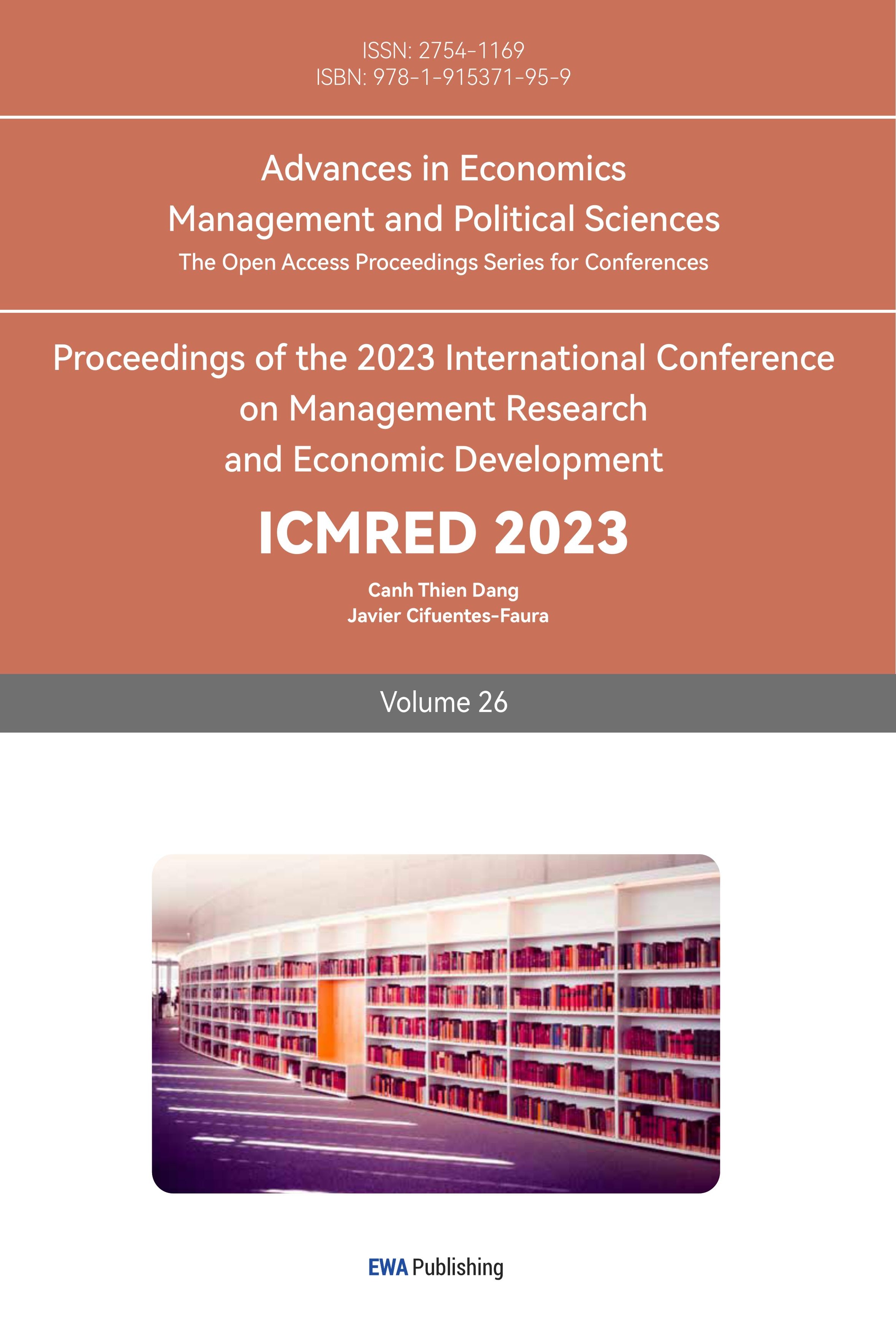References
[1]. Si Wang. Research on Enterprise Value Evaluation Based on DCF Model. National Circulation Economy (35),79-81 (2020). doi:10.16834/j.cnki.issn1009-5292.2020.35.026.
[2]. Williams, J.B. The Theory of Investment Value. Harvard University Press, Cambridge, MA. (1938)
[3]. Benjamin. Graham, David Dodd. Securities Analysis [M]. Beijing: Renmin University of China Press, (2009).
[4]. Penman, S. H & Sougiannis, T., A comparison of dividend, cash flow, and earnings approaches to equity valuation. Contemporary Accounting Research. 15, 3, 343 – 383 (1998).
[5]. Copeland, T., Koller, T. and Murrin, J., Valuation: Measuring and managing the value of companies. John Wiley & Sons Co. New York (1990).
[6]. Ahmed. S.Wafi Hassan Hassan Adel Mabrouk. Fundamental Analysis Models in Financial Markets–Review Study.Procedia Economics and Finance, Vol 30, 939-947 (2015). https://doi.org/10.1016/S2212-5671(15)01344-1
[7]. Zhengjun Min. The Application of Discount Model in Enterprise Value Evaluation (2014).
[8]. Shiwei Song. Enterprise Value Evaluation of New Energy Vehicles Based on DCF Model——Taking BYD Co., Ltd. as an Example. Time-honoured Brand Marketing (07), 89-90, (2021).
[9]. Chenglong Wei & Junzhi Chen, A study on the valuation of listed companies based on the improved DCF model in Guizhou——Take Guizhou as an example. Research on Generalized Virtual Economy (01), 57-68 (2017).
[10]. Yongqi Chen. Research on the Applicability of the DCF Model in Different Interest Rate Environments. International Business Accounting (14), 22-25 (2022).
[11]. Tianao Qu Value evaluation of new energy battery companies based on DCF model: Taking CATL as an example.International Business Accounting (14), 86-88 (2022).
[12]. Zheming Jiang. Why DCF Model cannot Fairly Value Technology Giants Like Alibaba. (eds.) Proceedings of 2nd International Conference on the Frontiers of Innovative Economics and Management (FIEM 2021) pp.8-14 (2021).
[13]. Gai Junyue Buffett’s Value Investment Theory Based on Improved DCF Model [J] Wireless Communications and Mobile Computing, (2022).
Cite this article
Cui,M. (2023). Discussion on the Advantages and Disadvantages of the DCF Model in the Current Era and the Improvement of the Model. Advances in Economics, Management and Political Sciences,26,61-65.
Data availability
The datasets used and/or analyzed during the current study will be available from the authors upon reasonable request.
Disclaimer/Publisher's Note
The statements, opinions and data contained in all publications are solely those of the individual author(s) and contributor(s) and not of EWA Publishing and/or the editor(s). EWA Publishing and/or the editor(s) disclaim responsibility for any injury to people or property resulting from any ideas, methods, instructions or products referred to in the content.
About volume
Volume title: Proceedings of the 2023 International Conference on Management Research and Economic Development
© 2024 by the author(s). Licensee EWA Publishing, Oxford, UK. This article is an open access article distributed under the terms and
conditions of the Creative Commons Attribution (CC BY) license. Authors who
publish this series agree to the following terms:
1. Authors retain copyright and grant the series right of first publication with the work simultaneously licensed under a Creative Commons
Attribution License that allows others to share the work with an acknowledgment of the work's authorship and initial publication in this
series.
2. Authors are able to enter into separate, additional contractual arrangements for the non-exclusive distribution of the series's published
version of the work (e.g., post it to an institutional repository or publish it in a book), with an acknowledgment of its initial
publication in this series.
3. Authors are permitted and encouraged to post their work online (e.g., in institutional repositories or on their website) prior to and
during the submission process, as it can lead to productive exchanges, as well as earlier and greater citation of published work (See
Open access policy for details).
References
[1]. Si Wang. Research on Enterprise Value Evaluation Based on DCF Model. National Circulation Economy (35),79-81 (2020). doi:10.16834/j.cnki.issn1009-5292.2020.35.026.
[2]. Williams, J.B. The Theory of Investment Value. Harvard University Press, Cambridge, MA. (1938)
[3]. Benjamin. Graham, David Dodd. Securities Analysis [M]. Beijing: Renmin University of China Press, (2009).
[4]. Penman, S. H & Sougiannis, T., A comparison of dividend, cash flow, and earnings approaches to equity valuation. Contemporary Accounting Research. 15, 3, 343 – 383 (1998).
[5]. Copeland, T., Koller, T. and Murrin, J., Valuation: Measuring and managing the value of companies. John Wiley & Sons Co. New York (1990).
[6]. Ahmed. S.Wafi Hassan Hassan Adel Mabrouk. Fundamental Analysis Models in Financial Markets–Review Study.Procedia Economics and Finance, Vol 30, 939-947 (2015). https://doi.org/10.1016/S2212-5671(15)01344-1
[7]. Zhengjun Min. The Application of Discount Model in Enterprise Value Evaluation (2014).
[8]. Shiwei Song. Enterprise Value Evaluation of New Energy Vehicles Based on DCF Model——Taking BYD Co., Ltd. as an Example. Time-honoured Brand Marketing (07), 89-90, (2021).
[9]. Chenglong Wei & Junzhi Chen, A study on the valuation of listed companies based on the improved DCF model in Guizhou——Take Guizhou as an example. Research on Generalized Virtual Economy (01), 57-68 (2017).
[10]. Yongqi Chen. Research on the Applicability of the DCF Model in Different Interest Rate Environments. International Business Accounting (14), 22-25 (2022).
[11]. Tianao Qu Value evaluation of new energy battery companies based on DCF model: Taking CATL as an example.International Business Accounting (14), 86-88 (2022).
[12]. Zheming Jiang. Why DCF Model cannot Fairly Value Technology Giants Like Alibaba. (eds.) Proceedings of 2nd International Conference on the Frontiers of Innovative Economics and Management (FIEM 2021) pp.8-14 (2021).
[13]. Gai Junyue Buffett’s Value Investment Theory Based on Improved DCF Model [J] Wireless Communications and Mobile Computing, (2022).









